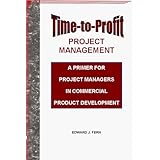
Average Reviews:

(More customer reviews)Time-to-Profit Project Management:A Primer for Project Managers in Commercial Product Development
Reviewed by David S. Jacob, Principal, Doren Associates, President PMI-Orange County Chapter
To borrow a thoughtfrom the CEO of Microsoft soon-to-be published latest book, Bill Gates' NewRules, "If the 1980s were about quality and the 1990s were aboutre-engineering, then the 2000s will be about velocity." - then EdwardFern's new book, "Time-to-Profit Project Management", is a "must-read" forproject managers who aspire to lead and rapidly deliver successful productdevelopment projects in the next millennium.
Mr. Fern has placed a newperspective on the word "profit", by infusing it with a non-traditionalmeaning. As he points out, "profit is the total benefit that a companyreceives from its customers in exchange for the value it delivers to them.In this context "profit" is not merely the traditional measure of thedifference between revenue and expense. Rather, when juxtaposed with"time", ... "it empowers a company to build relationships with customersthat transcend the incidentalpurchase of a product".
The first twochapters define what is "time-to-profit"and stresses the validity andimportance of its use. The author provides a rich collection of anecdotalsituations - both follies and successes -to support and validate the needfor the time-to-profit process. To attest to the universality of"time-to-profit", these anecdotes range over a wide array of industries,such as the demise of McDonnell Douglas as an independent aircraftmanufacturer, the fierce competition amongst several drug companies intheir rush to market "quit- smoking" products, and Chrysler's initial andcontinued dominance in the mini-van automobile market.
Chapter 3introduces the reader to the novel concept of the Ten-P ParadigmTM fornew product development, including:
1. Positioning - identifying anddistinguishing your new product from your competitors.
2. Planning -organizing your product development activities into developmentstages.
3. Partnering - identifying and enlisting strategicpartners.
4. Producing - identifying and securing capabilities tosuccessfully penetrate the market. 5. Processing - identifying anddeveloping ancillary processes to achieve success.
6. Packaging -determining the extent and nature of bundling, appropriate for themarket.
7. Pricing - determining the pricing structure to maximizerevenues and profits.
8. Promoting - identifying and implementing theappropriatemeans of heightening market awareness of the product.
9.Placing - identifying, enlisting and training appropriate marketingchannels.
10. Pleasing - identifying and supporting customer servicerequirements.
Each of the these Ten-P ParadigmTM elements are viewed as"sources of value" within what the author defines as the four distinctstages of the time-to-profit "race":
1. Incubation stage- subgrouped intoidea capture and incubation, product conceptualization, preliminary anddetailed investigations and preliminary development.
2. Elaboration stage- subgrouped into Alpha product development, alpha production, testing& validation and test marketing.
3. Adaptation stage - subgroupedinto design modification, beta development, production, testing &validation and marketing.
4. Contention stage - subgrouped into delivery& support, product discontinuation and project closeout.
Chapter 4comprehensively develops a stage, phase and gate methodology in the form ofa matrix, relating the Ten-P ParadigmTM elements to the fourtime-to-profit stages. The matrix demonstrates what impact each of theTen-P ParadigmTMsources of value has on each of the developmentsubgroups, by establishing whether it is mandatory, elective or prohibited.This chapter is replete with illustrations and a well-written narrative toarticulate the methodology.
As with all emerging project managementconcepts worth their salt, Chapter 5 demonstrates how "time-to-profit" seamlessly integrates within the Project Management Institute's, A Guide tothe Project Management Body of Knowledge, encompassing integration, scope,time, cost, quality, human resources, communications, risk andprocurement.
The book concludes with an excellent discussion in Chapter 6on an array of proposed techniques - including a triple loop learningtechnique - to improve any company's product development systems andprocesses.
But that's not all! There is an superb set of appendixes,starting with Appendix A, which provides a set of checklist questions foreach of the Ten-P ParadigmTMsources of value, to preclude overlooking keyelements in a project plan. Appendix B provides a rich bibliography,including a series of related websites.
Overall the writing style is easyto read from cover-to-cover, and can be readily used as a desk reference oras a textbook.
Click Here to see more reviews about: Time-to-Profit Project Management: A Primer for Project Managers in Commercial Product Development
Product Description:
Time-to-Profit Project Management is about winning the time-to-profit product development race. The popular time-to-market concept is about being the first to develop, produce, and launch a product. Time-to-profit is more comprehensive than time-to-market.Time-to-profit begins before the product development process, in the management of new product ideas that are not yet product development projects. Time-to-profit endures beyond product launch and continues until a successor product allows completion of close-out activities. Time-to-profit is broader than time-to-market. It includes activities traditionally associated with marketing, sales, and customer service. Winning the time-to-profit race means perfecting all of the elements that the market anticipates. It means going the extra step to exceed customer expectations.
Want to read more honest consumer review about Time-to-Profit Project Management: A Primer for Project Managers in Commercial Product Development now ?

0 comments:
Post a Comment